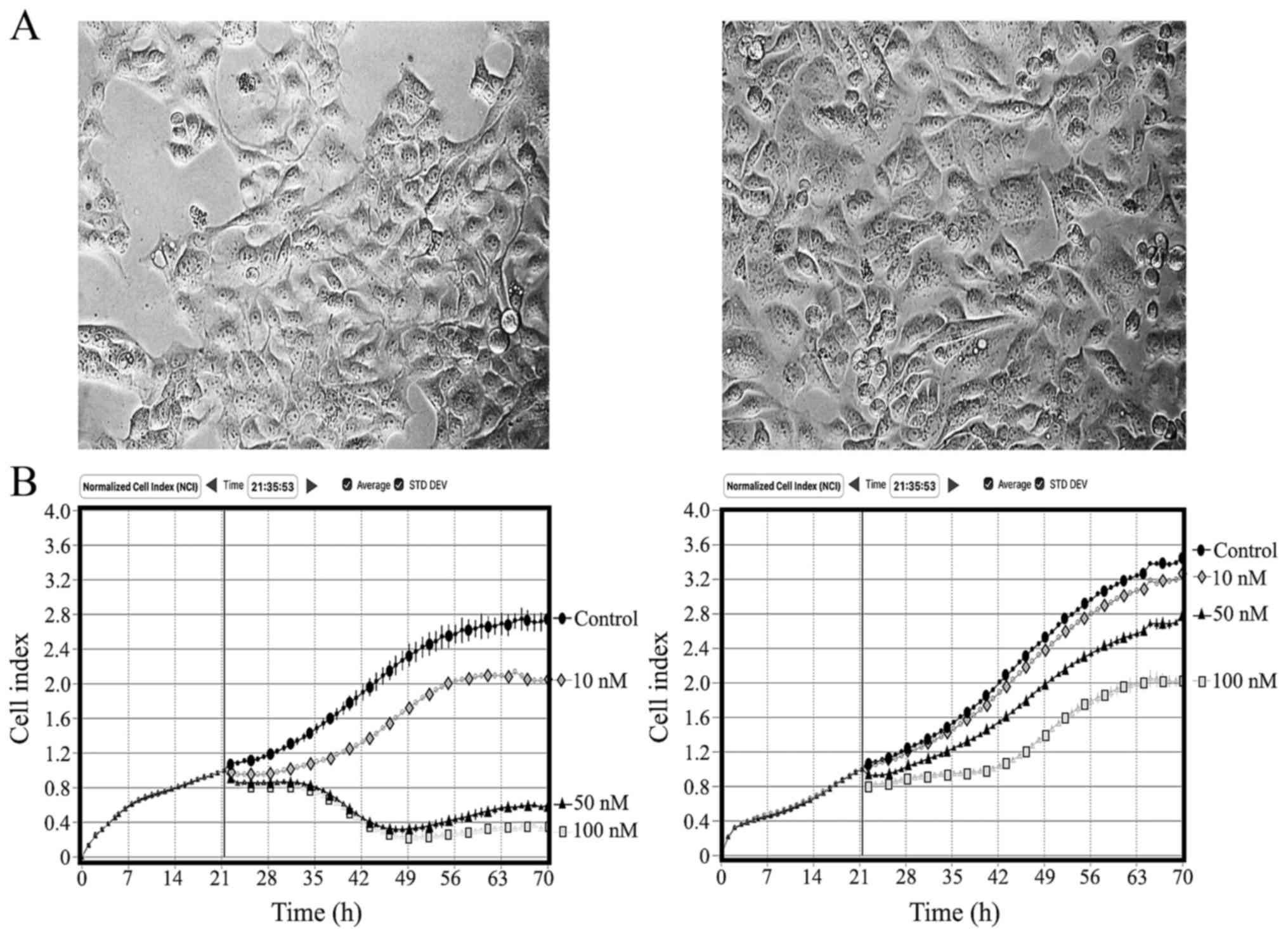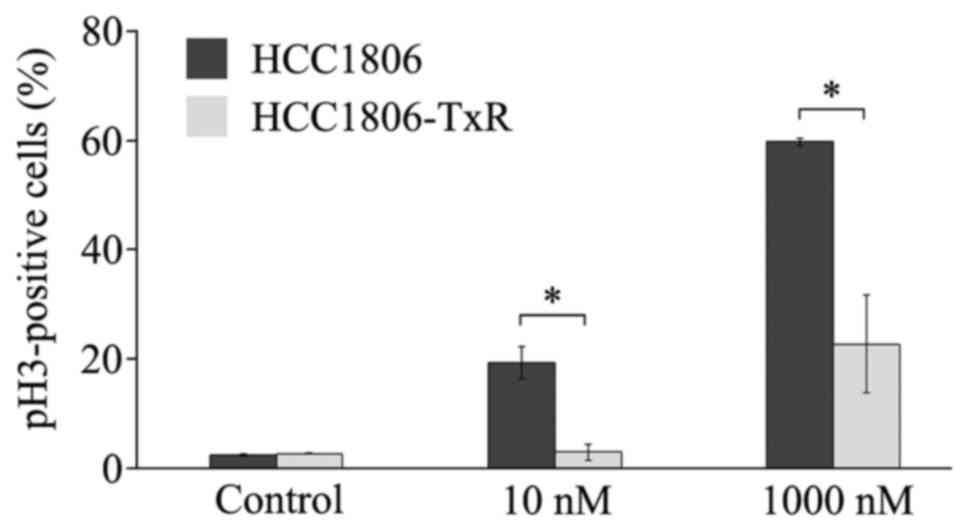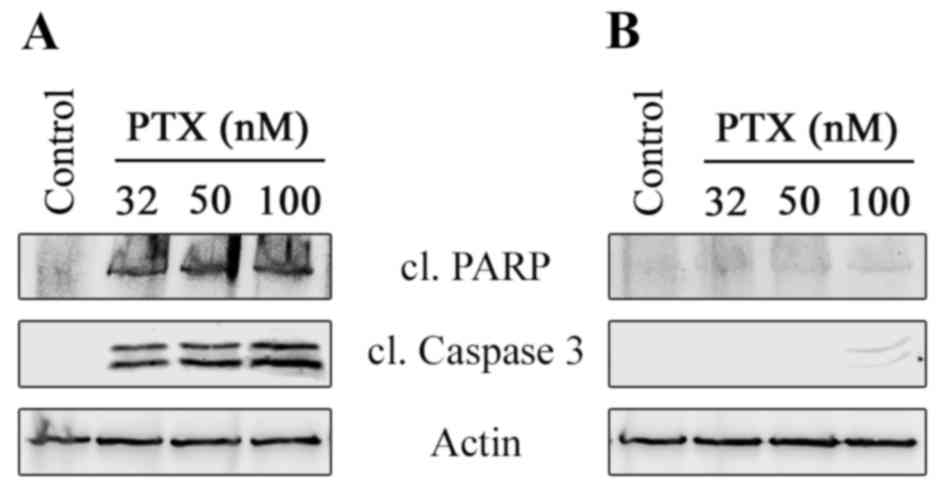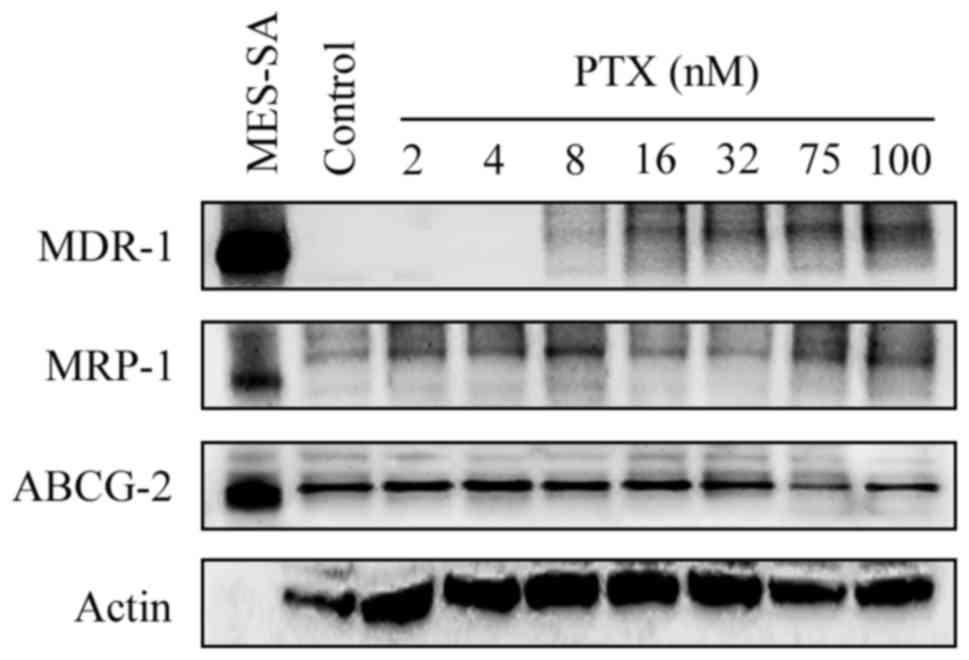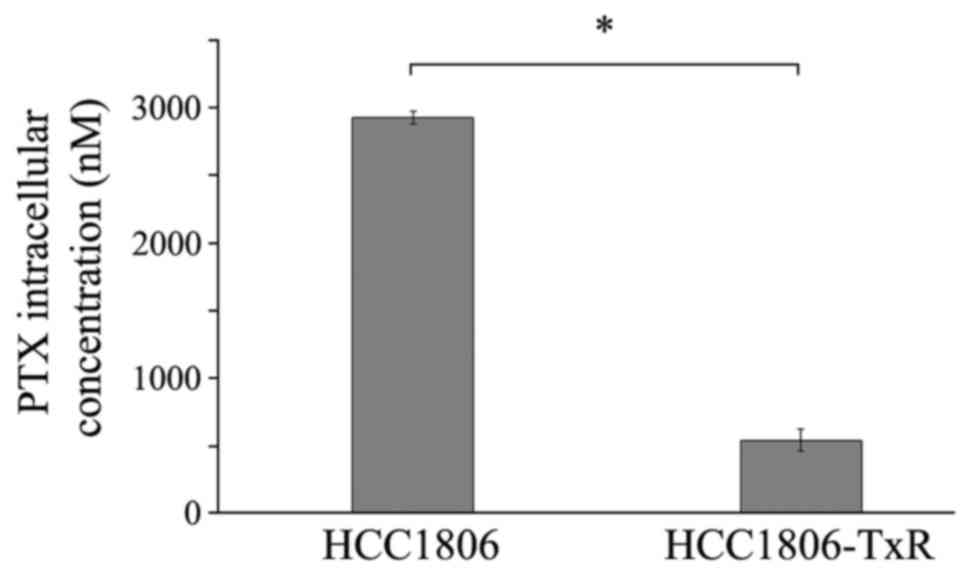Establishment and characterization of a triple negative basal‑like breast cancer cell line with multi‑drug resistance
- Authors:
- Published online on: August 23, 2017 https://doi.org/10.3892/ol.2017.6795
- Pages: 5039-5045
Abstract
Introduction
A total of 12–25% of all cases of breast cancer are characterized by the lack of expression of the estrogen receptor and progesterone receptor in addition to the absence of the overexpression of human epidermal growth factor receptor-2 (HER-2), and are therefore classified as triple-negative breast cancer (TNBC) (1). TNBC is amongst the most aggressive subtypes of breast cancer, which is unresponsive to hormonal therapy and HER-2-targeted antibody therapy (2). Thus, TNBC is characterized by poor overall survival time, predominantly due to the unavailability of strategies for specific therapy. Cytotoxic chemotherapy is currently the main therapeutic option for TNBC (2), including anthracyclines (for example doxorubicin) and/or microtubule-binding agents (TBAs; such as taxans). The molecular mechanism of action for TBAs is associated with cell cycle arrest, predominantly at G2/M; apoptosis is induced as a consequence of mitotic exit failure or ‘mitotic catastrophe’ (3–5). A number of TBAs are in broad use in the clinical treatment of TNBC. Although certain patients initially respond to these classical cytotoxic drugs, patients exhibit high rates of systemic relapse during early stages and decreased overall survival times following metastasis (6,7). This may be due to drug resistance development arising from the overexpression of drug-efflux pumps, including the multidrug resistance (MDR)-associated transporter P-glycoprotein (MDR-1) or proteins from the MDR-associated protein (MRP) family, collectively members of the ATP-binding cassette (ABC) transporter superfamily (8,9).
Furthermore, non-target-specific chemotherapy is toxic, and the use of anthracyclines and TBAs is limited by multiple side-effects, including cardiotoxicity, myelo- and immunosuppression, neutropenia, mucositis and fluid retention; the drugs also exhibit low bioavailability. Thus, there is an urgent requirement for the development of novel, safe, and effective therapeutic options for TNBC. To achieve this goal, appropriate models for the analysis of the mechanisms to bypass MDR in TNBC are required.
In the present study, a paclitaxel-resistant (TxR) HCC1806-derived breast cancer cell subline that harbored a MDR phenotype, with cross-resistance to anthracyclines and TBAs, was established and characterized. This HCC1806-TxR TNBC subline may serve as an appropriate model for analyzing the chemoresistance mechanisms of TNBC, and to allow the study of potential novel methods for bypassing MDR.
Materials and methods
Chemical compounds
Doxorubicin, paclitaxel, vinblastine and cisplatin were purchased from Sigma-Aldrich (Merck KGaA, Darmstadt, Germany); etoposide was obtained from Calbiochem (EMD Millipore, Billerica, MA, USA).
Antibodies
The primary antibodies used for western blotting and flow cytometry were as follows: anti-ABC subfamily G member 2 (ABCG-2; cat. no. 42078P; Cell Signaling Technology Inc., Danvers, MA, USA), Alexa-488-conjugated anti-phosphorylated histone subunit H3 S10 (pH3 S10; cat. no. 9708S; Cell Signaling Technology Inc., Danvers, MA, USA), cleaved caspase-3 (cat. no. 9661S; Cell Signaling Technology, Inc.), anti-PARP (cat. no. 436400; Invitrogen; Thermo Fisher Scientific, Inc., Waltham, MA, USA), MDR-1 (cat. no. sc-55510) MRP-1 (cat. no. sc-18835) and β-actin (cat. no. sc-8432; Santa Cruz Biotechnology, Dallas, TX, USA); HRP-conjugated secondary antibodies [anti-mouse immunoglobulin (Ig)G, cat. no. sc-2005; anti-rabbit IgG, cat. no. sc-2004] for western blotting were purchased from Santa Cruz Biotechnology, Inc.
Cell lines and culture conditions
MES-SA/Dx5 Cell Lysate was obtained from Santa Cruz Biotechnology (cat. no. sc-2284). The human basal-like TNBC cell line, HCC1806, was purchased from American Type Culture Collection (Manassas, VA, USA) and maintained in RPMI-1640 medium supplemented (Paneco, Moscow, Russia) with 10% fetal bovine serum (Gibco; Thermo Fisher Scientific, Inc., Waltham, MA, USA), 1% L-glutamine, 50 U/ml penicillin and 50 µg/ml streptomycin. To establish a TxR TNBC subline, HCC1806 cells were initially incubated in 0.5 nM paclitaxel for 4 weeks. When stable growth was achieved, the paclitaxel concentration was doubled every 4–5 weeks over 8 months to a maximum dose of 100 µM. Prior to experimental use, TxR-cells were maintained in paclitaxel-free culture medium as previously described, and passaged at least 3 times. All cells were cultured at 37°C in a humidified atmosphere of 5% CO2 in an incubator (Lamsystems, Miass, Russia) throughout the present study.
Intracellular drug concentration
НСС1806 and HCC1806-TxR cells were exposed to 100 nM paclitaxel for 2 h. Cells were rinsed twice with ice-cold PBS, harvested into centrifuge tubes, centrifuged at 250 × g for 5 min at room temperature and collected for solid-phase extraction high performance liquid chromatography (HPLC; LC-20 Prominence; Shimadzu Corporation, Kyoto, Japan). The detection wavelength was 227 nm and the limit of detection for paclitaxel was 5.0 ng. Experimental conditions were as follows: mobile phase; water and acetonitrile in a ratio of 40:60; Ascentis® C18 column, 4.6×250 mm; guard cartridge, Ascentis® C18 Supelguard with 5 µm particle size, 20×4 mm; isocratic mode (flow rate, 1 ml/min; temperature, 40°C; pressure, 35 bar; Sigma-Aldrich). Paclitaxel (Sigma-Aldrich) was used as the internal standard. The method of absolute calibration was used for the quantitation of paclitaxel. The intracellular concentration of paclitaxel was defined as the total amount of paclitaxel/106 cultured cells.
Cellular survival assay
Exponentially growing cells were seeded (3.2×104 cells/well) into the 96-well flat-bottomed plates (Corning Incorporated, Corning, NY, USA) and incubated for 24 h at 37°C with RPMI-1640 culture medium. The cells were then cultured for 24 or 48 h at a range of concentrations of chemotherapeutic agents, including paclitaxel (1 nM-10 µM), doxorubicin (0, 03125-8 µg/ml), vinblastine (1 nM-10 µM), cisplatin (0, 03125-80 µM) or etoposide (2, 5-640 µM). All the aforementioned agents were previously diluted in dimethyl sulfoxide (DMSO). DMSO was used as a negative control in untreated cells. MTS reagent (CellTiter 96® Aqueous Non-Radioactive Cell Proliferation Assay; Promega Corporation, Madison, WI, USA) was added at 2 mg/ml to assess the relative number of viable cells. The MTS and cells were incubated for ≥1 h and the production of formazan, dissolved using DMSO, was assessed by the relative absorbance at 492 nm on a MultiScan FC plate reader (Thermo Fisher Scientific, Inc.). The resulting IC50 values were defined as the compound concentration required to inhibit cellular growth by 50% after 48 h of post treatment. The data was normalized to the DMSO control group.
Real-time monitoring of cell proliferation using an i-CELLigence system
An in vitro growth curve characterization of HCC1806 parental and TxR cells cultured in the presence of paclitaxel was performed using an iCELLigence system (ACEA Biosciences, Inc., San Diego, CA, USA). Cells (5×104) were seeded in electronic microtiter plates (E-Plate; Roche Diagnostics, Basel, Switzerland) and incubated for 24 h to obtain the growth baseline reading. Then cells were treated with 10, 50 or 100 nM paclitaxel in triplicate, and cell index (CI) measurements were obtained, with a signal detected every 30 min until the end of the experiment (72 h). Normalized CI values were calculated with RTCA iCelligence software version 1.1.1 (Roche Diagnostics).
Western blot analysis
For western blot analysis, whole-cell extracts were prepared by scraping HCC1806 parental and TxR cells, or MES-SA control cells, into radioimmunoprecipitation buffer (1% NP-40, 50 mM Tris-HCl pH 8.0, supplemented with protease and phosphatase inhibitors). The cellular lysates were incubated for 1 h at 4°C and then clarified by centrifugation for 30 min at 14,000 × g at 4°C. Protein concentrations were measured by the Bradford assay. Samples containing 30 µg of protein were resolved on 4–12% Bis-Tris or 3–8% Tris-acetate NuPAGE gels (Invitrogen; Thermo Fisher Scientific, Inc.), transferred to a nitrocellulose membrane (Bio-Rad Laboratories, Inc., Hercules, CA, USA), probed with primary (1:1,000 and incubated overnight at 4°C), and secondary antibodies (1:1,000 and incubated for 1 h at room temperature) and visualized with enhanced chemiluminescence (Western Lightning Plus-ECL reagent, PerkinElmer, Inc., Waltham, MA, USA). The MES-SA cells acted as a positive control for ABC protein expression.
Cell cycle analysis
For flow cytometry cell cycle analysis, the cells were treated with paclitaxel at 10 or 1,000 nM for 24–48 h and trypsinized. Subsequent to centrifuging at 300 × g for 5 min at room temperature, the cells were washed in PBS, fixed in 4% paraformaldehyde and permeabilized with ice-cold 90% methanol. The washed cells were stained with Alexa-488-conjugated anti-pH3 S10 (1:500 and incubated for 1 h at room temperature in the dark), were then counterstained with propidium iodide (30 min at room temperature in the dark) (Sigma-Aldrich) and analyzed by fluorescence-activated cell sorting on a FC500 flow cytometer (Beckman Coulter, Inc., Brea, CA, USA). Cells were counted and analyzed using the Kaluza software version 1.3 (Beckman Coulter, Inc.).
RNA extraction and reverse transcription-quantitative polymerase chain reaction (RT-qPCR)
At 24 h after plating 1×106 HCC1806 or HCC1806-TxR cells, total RNA was extracted using TRIzol reagent (cat. no. BC032; Invitrogen; Thermo Fisher Scientific, Inc.) according to the manufacturer's protocol and resuspended in diethyl pyrocarbonate-treated H2O. RNA was reverse transcribed to cDNA using the Moloney murine leukemia virus reverse transcriptase kit (Evrogen JSC, Moscow, Russia) according to the manufacturer's protocol (cat. no. SK021), and subjected to qPCR. A total of 1 µl template cDNA was used in the qPCR reaction, with 5X qPCRmix-HS SYBR (Evrogen JSC) and 10 mM of each forward and reverse primer (Table I). qPCR was performed with the CFX96 Real-Time detection system (Bio-Rad Laboratories, Inc.), according to the manufacturer's protocol. Thermal cycling conditions were as follows: 3 min at 95°C, 45 cycles (15 sec at 95°C, 10 sec at 56°C, 30 sec at 72°C) and a final extension step of 5 min at 72°C. Each sample was processed in parallel with assays for GAPDH and the absolute levels of each mRNA were normalized relative to GAPDH. The 2−∆∆Cq method (10) was then used to calculate relative gene expression.
Statistical analysis
All experiments were repeated a minimum of 3 times. The results are presented as the mean ± standard deviation for each group. Statistical analyses (Student's t-test, Mann-Whitney U test) were performed using Statistical software program version 7.0 (S.A. Glantz, McGraw Hill Education, NY, USA) and GraphPad Prism version 4.0 (GraphPad Software, Inc., La Jolla, CA, USA). P<0.05 was considered to indicate a statistically significant difference.
Results
Establishment of taxol-resistant HCC1806 breast cancer cell line
The HCC1806-TxR cell line was established following a continuous treatment with a gradually increasing concentration of paclitaxel, from 0.5–100 nM. Approximately 8 months and 55 passages were required to develop HCC1806 cells with stable drug resistance. It was then demonstrated that НСС1806-TxR cells were less sensitive to paclitaxel treatment when compared with parental HCC1806 cells; the paclitaxel drug resistance index was 16.86 (Table II). In addition to resistance to paclitaxel, HCC1806-TxR cells exhibited cross-resistance to vinblastine, doxorubicin and etoposide (drug resistance index, 14.65, 4.36 and 3.18, respectively), whereas there was no identified cross-resistance to cisplatin. Paclitaxel resistance in HCC1806-TxR cells remained stable following 1 month of culturing without paclitaxel and following storage at −80°C for 6 months (data not shown).
Alterations in cellular morphology and growth kinetics
The morphology of the TxR cells was distinct from the parental cells. HCC1806-TxR cells exhibited an enlarged and oval-shaped morphology, and an increased nucleus/cytoplasm ratio when compared with the parental cells (Fig. 1A). The resistant cells were consistent in size and shape in monolayer proliferation, and their growth kinetics were different from those of the parental cells (Fig. 1B). When cells were cultured with paclitaxel, a difference in growth kinetics between the TxR and parental HCC1806 cells was also detected (Fig. 1B), which was consistent with the MTS-based cytotoxicity data (Table II).
Paclitaxel induced cell accumulation in M-phase and apoptosis in parental, but not TxR, HCC1806 cells
As the major mechanism for the action of paclitaxel is the inhibition of tubulin depolymerization to induce apoptosis due to ‘mitotic catastrophe’, the ability of paclitaxel to induce the accumulation of cells in M-phase in parental vs. paclitaxel-resistant HCC1806 cells was compared. pH3 S10 staining was combined with propidium iodide DNA staining to count the number of mitotic cells by flow cytometry. An increase of the pH3 S10-positive (i.e., mitotic) HCC1806 cells was observed subsequent to 10 or 1,000 nM paclitaxel exposure (Fig. 2). In contrast, the number of mitotic paclitaxel-treated HCC1806-TxR cells was significantly less when compared with parental cells (P<0.001 for 10 and 1,000 nM; Fig. 2).
To assess the ability of paclitaxel to induce apoptosis in parental vs. TxR HCC1806 cells, the expression of cleaved caspase-3 and PARP, specific markers for apoptosis, was observed. An increase in the cleavage of PARP and caspase-3 was detected in paclitaxel-treated HCC1806 cells, reflecting the ability of paclitaxel to induce apoptosis in HCC1806 parental cells (Fig. 3A). In contrast, relatively low cleavage of PARP and caspase-3 were observed in paclitaxel-treated HCC1806-TxR cells (Fig. 3B), thereby confirming the cytotoxicity MTS-based data by indicating the resistance of the HCC1806-TxR subline to paclitaxel.
The expression of chemoresistance-associated genes is altered in HCC1806-TxR cells
As the resistance of patient tumors to chemotherapeutic agents is highly dependent on the activities of the transporters that efflux drugs from tumor cells, the expression of the MDR-1, MRP-1 and ABCG2 ABC transporter proteins in HCC1806-TxR cells was assessed. Western blot analysis revealed the overexpression of the MDR-1 and MRP-1 proteins in HCC1806-TxR cells when compared with the parental HCC1806 cells (Fig. 4). However, the expression level of another protein associated with the MDR phenotype, ABCG2, was unchanged between the parental and TxR lines.
Since a potential mechanism for MDR-1 overexpression in paclitaxel-resistant cells is the induction by Y-box-binding protein 1 (YB-1), which binds to a cis-acting element of the MDR-1 promoter to increase MDR-1 mRNA expression (11), YB-1 mRNA levels were compared between parental HCC1806 cells and the TxR subline. There was an increase (3.6-fold) of YB-1 mRNA expression in TxR-cells when compared with the parental HCC1806 cells (Table III). Similarly, a number of MRP mRNAs were observed to be overexpressed in HCC1806-TxR cells when compared with the parental HCC1806 cells (Table III). In TxR cells, the levels of MRP-1, −5, and −6 were elevated to 2.3, 15.7 and 5.7-fold, respectively. As paclitaxel-induced cell death is associated with the activation of apoptosis mechanisms, the expression of the apoptosis-related genes, Bcl-2 associated X (Bax), Bcl-2, caspase-8 and Fas, were compared in parental vs. TxR cells. The expression of Bax and caspase-8 mRNA were unchanged in resistant cells, but a trend towards the downregulation of Fas was observed when compared with parental cells. In contrast, Bcl-2 expression was upregulated in the TxR subline (Table III).
Table III.Alterations in the expression level of chemoresistance and apoptosis associated genes in HCC1806-TxR cells relative to HCC1806 cells, as determined by reverse transcription-quantitative polymerase chain reaction. |
Intracellular drug concentration
As cellular mechanisms for drug resistance include a decline of intracellular drug concentrations as a result of increased efflux by overexpressed ABC proteins, and considering the overexpression of MDR-1 and MRP-related genes in the TxR cells, the intracellular paclitaxel concentrations in HCC1806 cells were compared with HCC1806-TxR cells. As presented in Fig. 5, at 2 h of paclitaxel exposure, HCC1806-TxR-cells contained ~540 ng paclitaxel, which was much lower than in the parental HCC1806 cells (2,930 ng; P<0.05).
Discussion
In the present study, a paclitaxel-resistant basal-like TNBC cell line was established from the parental HCC1806 cell line. The paclitaxel IC50 value for HCC1806-TxR cells was ~17-fold higher when compared with parental HCC1806 cells. Of note, the paclitaxel resistance remained stable after 1 month of culturing without paclitaxel and following storage at −80°C for 6 months. HCC1806-TxR cells exhibited alterations to cellular morphology (for example enlarged, oval-shaped) when compared with parental cells. Additionally, increased growth was observed in HCC1806-TxR cells exposed to paclitaxel compared with the parental HCC1806 cells.
Paclitaxel is a commonly used chemotherapeutic drug for the treatment of patients with a range of types of cancer, including breast, ovarian and lung cancer (12–14). The molecular mechanism for the action of paclitaxel is its ability to bind microtubules and induce their stabilization, thus preventing their disassembly during mitosis (3,5). Therefore, in paclitaxel-treated cells, microtubules become locked in a polymerized state, which leads to G2/M arrest, induces the accumulation of cells in M-phase and leads to cell death via apoptosis (15–18). Thus, a substantial decrease of mitotic and apoptotic cell amount in TxR-subline after paclitaxel exposure was expected. Indeed, a substantial decrease of pH3 S10-positive (i.e., mitotic) cells (Fig. 2) and a low level of PARP and caspase-3 cleavage of in paclitaxel-treated HCC1806-TxR cells was observed when compared with parental HCC1806 cells (Fig. 3B). This data was consistent with the cytotoxicity MTS-based data, indicating the resistance of the HCC1806-TxR subline to paclitaxel.
Additionally, HCC1806-TxR exhibited a cross-resistance to other types of chemotherapeutic agents, including vinblastine, and etoposide and doxorubicin topoisomerase type II inhibitors. The resistance indexes for the drugs indicated above were 14.65, 4.36 and 3.18, respectively. This data is consistent with previous study, indicating that cancer cells in culture becoming resistant to a single drug may become resistant to a class of drugs with a similar mechanism of action as well (19). In addition, cancer cells may acquire a cross-resistance to structurally and mechanistically unrelated drugs; this phenomenon is known as MDR. For example, McDonald et al previously demonstrated that docetaxel-resistant MDA-MB and MCF-7 breast cancer cells developed a cross-resistance to paclitaxel and vincristine (20), concordant to the findings of the present study. Multiple reports have indicated that resistant sublines commonly express MDR-1 and MRP proteins (9,21,22). Clinical studies also report the development of cross-resistance to multiple anticancer agents following the initial success of chemotherapy (23,24), which may also be due to the overexpression of MDR-1 and MRPs.
Thus, the molecular mechanism of cross-resistance of HCC1806-TxR to vinblastine and topoisomerase type II inhibitors may be due to the increased expression of ABC transporters, important mediators of drug efflux. An increased expression of MDR-1 and MRP-1 proteins in HCC1806-TxR cells was observed (Fig. 4), which may lead to the increased efflux of paclitaxel and other types of chemotherapeutic drugs (for example alkylating agents, topoisomerase type II inhibitors), resulting in MDR (Fig. 5).
In order to investigate the genes involved in paclitaxel resistance, the gene expression profile between HCC1806 and HCC1806-TxR cells was compared. MDR-1, MRP-1, −5 and −6 were upregulated in the HCC1806-TxR subline, suggesting that these factors served a function in the observed MDR phenotype. The increased activity of ABC transporters in the HCC1806-TxR subline was additionally confirmed by a marked (5.4-fold) decrease in the intracellular paclitaxel content in TxR-cells at 2 h of paclitaxel exposure when compared with parental HCC1806 cells (Fig. 5), thus indicating an increased efflux of chemotherapeutic drugs in the HCC1806-TxR subline. Furthermore, differences in expression of genes associated with apoptosis between the parental and TxR-cells, including Bcl-2 and Fas, were also detected. This data may also explain the low expression of apoptotic markers (cleaved PARP and caspase-3) in TxR cells subsequent to paclitaxel exposure when compared with parental HCC1806 cells (Fig. 3).
In conclusion, a HCC1806 subline was established with high resistance to paclitaxel, which also harbored a cross-resistance to diverse types of chemotherapeutic agents, including those with similar and different modes of action to paclitaxel. The MDR phenotype was associated with MDR-1, MRP-1, −5 and −6 overexpression, thus providing an effective efflux of anticancer drugs from HCC1806-TxR cancer cells. In addition, the TxR breast cancer subline also resisted apoptosis subsequent to the exposure to paclitaxel. This may be due to the downregulation of pro-apoptotic proteins (Fas) and the upregulation of anti-apoptotic proteins (Bcl-2). Paclitaxel resistance remained stable subsequent to 1 month of culturing without paclitaxel and following prolonged storage at −80°C. Taken together, the established MDR in a HCC1806-derived breast cancer subline may be appropriate for in vitro screenings of novel anticancer agents for overcoming MDR-mediated mechanisms in TNBC.
Acknowledgements
The present study was supported by a grant from the Russian Science Foundation (grant no. 14-15-00342).
References
|
Dent R, Trudeau M, Pritchard KI, Hanna WM, Kahn HK, Sawka CA, Lickley LA, Rawlinson E, Sun P and Narod SA: Triple-negative breast cancer: Clinical features and patterns of recurrence. Clin Cancer Res. 13:4429–4434. 2007. View Article : Google Scholar : PubMed/NCBI | |
|
Kassam F, Enright K, Dent R, Dranitsaris G, Myers J, Flynn C, Fralick M, Kumar R and Clemons M: Survival outcomes for patients with metastatic triple-negative breast cancer: Implications for clinical practice and trial design. Clin Breast Cancer. 9:29–33. 2009. View Article : Google Scholar : PubMed/NCBI | |
|
Jordan MA and Wilson L: Microtubules as a target for anticancer drugs. Nat Rev Cancer. 4:253–265. 2004. View Article : Google Scholar : PubMed/NCBI | |
|
Dumontet C and Jordan MA: Microtubule-binding agents: A dynamic field of cancer therapeutics. Nat Rev Drug Discov. 9:790–803. 2010. View Article : Google Scholar : PubMed/NCBI | |
|
Parker A, Kavallaris M and McCarroll JA: Microtubules and their role in cellular stress in cancer. Front Oncol. 4:1532014. View Article : Google Scholar : PubMed/NCBI | |
|
Bosch A, Eroles P, Zaragoza R, Viña JR and Lluch A: Triple-negative breast cancer: Molecular features, pathogenesis, treatment and current lines of research. Cancer Treat Rev. 36:206–215. 2010. View Article : Google Scholar : PubMed/NCBI | |
|
Yu KD, Zhu R, Zhan M, Rodriguez AA, Yang W, Wong S, Makris A, Lehmann BD, Chen X, Mayer I, et al: Identification of prognosis-relevant subgroups in patients with chemoresistant triple-negative breast cancer. Clin Cancer Res. 19:2723–2733. 2013. View Article : Google Scholar : PubMed/NCBI | |
|
Ullah MF: Cancer multidrug resistance (MDR): A major impediment to effective chemotherapy. Asian Pac J Cancer Prev. 9:1–6. 2008.PubMed/NCBI | |
|
Hasanabady MH and Kalalinia F: ABCG2 inhibition as a therapeutic approach for overcoming multidrug resistance in cancer. J Biosci. 41:313–324. 2016. View Article : Google Scholar : PubMed/NCBI | |
|
Livak KJ and Schmittgen TD: Analysis of relative gene expression data using real-time quantitative PCR and the 2(−Delta Delta C(T)) Method. Methods. 25:402–428. 2001. View Article : Google Scholar : PubMed/NCBI | |
|
Ohga T, Uchiumi T, Makino Y, Koike K, Wada M, Kuwano M and Kohno K: Direct involvement of the Y-box binding protein YB-1 in genotoxic stress-induced activation of the human multidrug resistance 1 gene. J Biol Chem. 273:5997–6000. 1998. View Article : Google Scholar : PubMed/NCBI | |
|
Holmes FA, Walters RS, Theriault RL, Forman AD, Newton LK, Raber MN, Buzdar AU, Frye DK and Hortobagyi GN: Phase II trial of taxol, an active drug in the treatment of metastatic breast cancer. J Natl Cancer Inst. 83:1797–1805. 1991. View Article : Google Scholar : PubMed/NCBI | |
|
Brown T, Havlin K, Weiss G, Cagnola J, Koeller J, Kuhn J, Rizzo J, Craig J, Phillips J and Von Hoff D: A phase I trial of taxol given by a 6-hour intravenous infusion. J Clin Oncol. 9:1261–1267. 1991. View Article : Google Scholar : PubMed/NCBI | |
|
McGuire WP, Rowinsky EK, Rosenshein NB, Grumbine FC, Ettinger DS, Armstrong DK and Donehower RC: Taxol: A unique antineoplastic agent with significant activity in advanced ovarian epithelial neoplasms. Ann Intern Med. 111:273–279. 1989. View Article : Google Scholar : PubMed/NCBI | |
|
Fuchs DA and Johnson RK: Cytologic evidence that taxol, an antineoplastic agent from Taxus brevifolia, acts as a mitotic spindle poison. Cancer Treat Rep. 62:1219–1222. 1978.PubMed/NCBI | |
|
Schiff PB, Fant J and Horwitz SB: Promotion of microtubule assembly in vitro by taxol. Nature. 277:665–667. 1979. View Article : Google Scholar : PubMed/NCBI | |
|
Haldar S, Jena N and Croce CM: Inactivation of Bcl-2 by phosphorylation. Proc Natl Acad Sci USA. 92:4507–4511. 1995. View Article : Google Scholar : PubMed/NCBI | |
|
Weaver BA: How Taxol/paclitaxel kills cancer cells. Mol Biol Cell. 25:2677–2681. 2014. View Article : Google Scholar : PubMed/NCBI | |
|
Guo B, Villeneuve DJ, Hembruff SL, Kirwan AF, Blais DE, Bonin M and Parissenti AM: Cross-resistance studies of isogenic drug-resistant breast tumor cell lines support recent clinical evidence suggesting that sensitivity to paclitaxel may be strongly compromised by prior doxorubicin exposure. Breast Cancer Res Treat. 85:31–51. 2004. View Article : Google Scholar : PubMed/NCBI | |
|
McDonald SL, Stevenson DA, Moir SE, Hutcheon AW, Haites NE, Heys SD and Schofield AC: Genomic changes identified by comparative genomic hybridization in docetaxel-resistant breast cancer cell lines. Eur J Cancer. 41:1086–1094. 2005. View Article : Google Scholar : PubMed/NCBI | |
|
Sharom FJ: ABC multidrug transporters: Structure, function and role in chemoresistance. Pharmacogenomics. 9:105–127. 2008. View Article : Google Scholar : PubMed/NCBI | |
|
Kim KY, Kim SH, Yu SN, Park SK, Choi HD, Yu HS, Ji JH, Seo YK and Ahn SC: Salinomycin enhances doxorubicin-induced cytotoxicity in multidrug resistant MCF-7/MDR human breast cancer cells via decreased efflux of doxorubicin. Mol Med Rep. 12:1898–1904. 2015. View Article : Google Scholar : PubMed/NCBI | |
|
Kröger N, Achterrath W, Hegewisch-Becker S, Mross K and Zander AR: Current options in treatment of anthracycline-resistant breast cancer. Cancer Treat Rev. 25:279–291. 1999. View Article : Google Scholar : PubMed/NCBI | |
|
Yonemori K, Katsumata N, Uno H, Matsumoto K, Kouno T, Tokunaga S, Yamanaka Y, Shimizu C, Ando M, Takeuchi M and Fujiwara Y: Efficacy of weekly paclitaxel in patients with docetaxel-resistant metastatic breast cancer. Breast Cancer Res Treat. 89:237–241. 2005. View Article : Google Scholar : PubMed/NCBI |



